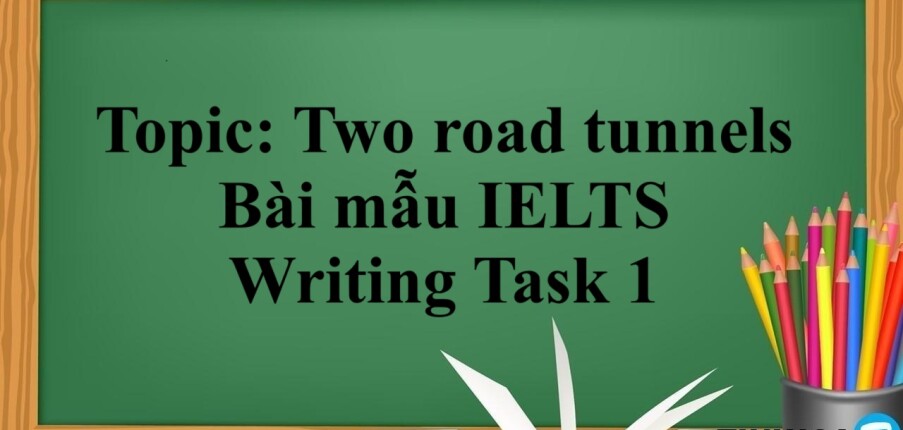Bài mẫu IELTS Writing Task 1 chủ đề Two road tunnels
Bài mẫu 1:
The provided images compare two different tunnels in two Australian cities.
Specifically about Tunnel A, at the depth of 25 metres underground, it is 2.2 kilometres long. Its location is below a river over which a suspension bridge is built. In terms of geology, the soil in this area contains mostly sand and stone. The construction took 5 years from 1987 to 1992 to complete and cost 556 million dollars. Inside, the tunnel has 2 carriageways with a total of 4 lanes for vehicles.
In contrast, Tunnel B is 3.6 kilometres long at 35 metres deep underground. It runs underneath an urban area with asphalt roads and high-rise buildings. It took only 3 years from 2004 to 2007 to construct Tunnel B, but the cost reached 1.1 billion dollars. Inside the tunnel, each of the carriageways has enough space for 3 lanes, adding up to 6 lanes in total.
In general, in addition to geological differences and measurements, Tunnel B cost more money but took less time to complete and can accomodate more traffic than Tunnel A. (180)
Vocabulary Takeaway:
- cross section [n]: mặt phẳng cắt để thể hiện các chi tiết bên trong sự vật (trong thiết kế, xây dựng, đồ họa)
- vehicle/ means of transport [n]: phương tiện giao thông
- traffic [n, Uncountable]: sự lưu thông của các phương tiện
- accommodate [v]: to have enough space for … có đủ chỗ cho ai/cái gì
- lane [n]: làn đường
- asphalt [n]: nhựa đường
- carriageway [n]: chiều của đường
- measurements [n]: các chỉ số đo lường (dài, rộng, cao, sâu v.v)
- geology [n] / geological [adj]: địa chất (thành phần, cấu tạo, đặc điểm trong lòng đất)
- high-rise building [n]: tòa nhà cao tầng
- underneath = below = under (sth) [adv / prep]: bên dưới …
Bài mẫu 2:
The given maps illustrate two different underground tunnel systems for cars in two Australian cities.
Overall, there are a number of differences between the two tunnel systems, in terms of the cost, size, length, time of construction, and the surrounding environment. The first tunnel cost approximately half as much as the second tunnel to construct, however, the first tunnel was significantly smaller in terms of length and vehicle capacity. The first tunnel also took much longer to construct.
The first tunnel, which took twelve years to construct between 1986 and 1998, cost $555 million, and was built underneath a body of water and sand. Meanwhile, the second tunnel only took four years for completion but cost twice as much, at $1.1 billion, and was constructed beneath a layer of stone and clay.
The size of the tunnels was also substantially different, with the first tunnel being 1.5 meters high and 2.2km long, and the second tunnel being 2.5m high and 3.6 km long. The first tunnel system is four lanes wide, while the second tunnel system is six lanes wide.
Vocabulary:
- surrounding environment(n): môi trường xung quanh
- vehicle capacity (n): sức chứa phương tiện giao thông
- a body of water and sand (n): một khối nước và cát
- a layer of stone and clay (n): 1 lớp đá và đất sét
Cấu trúc ngữ pháp
- In terms of something: về khía cạnh nào đó
Người học sử dụng cấu trúc này để chỉ những khía cạnh mà người học đang muốn so sánh giữa các đối tượng.
Ví dụ: There are a number of differences between the two tunnel systems, in terms of the cost, size, length, time of construction, and the surrounding environment.
- S + V + multiple number + as much/many as + Noun/Pronoun : …. bằng bao nhiêu lần …
Cấu trúc so sánh về số lần: Người học sử dụng cấu trúc để chỉ so sánh đối tượng thứ nhất bằng bao nhiêu lần đối tượng thứ hai.
As much as: sử dụng khi so sánh đại lượng không đếm được
As many as: sử dụng khi so sánh đại lượng đếm được
Một số từ chỉ số lần (multiple number) trong tiếng Anh: half (một nửa), twice (gấp đôi), three times (ba lần), four times (bốn lần) (từ gấp ba lần trở lên thì từ chỉ số lần là số đếm + times).
Ví dụ:
The first tunnel cost approximately half as much as the second tunnel to construct.
The second tunnel cost twice as much as the first tunnel.
- Meanwhile, the second tunnel only took four years for completion but cost twice as much, at $1.1 billion, and was constructed beneath a layer of stone and clay.
Cấu trúc rút gọn: Mệnh đề trên có ba vế. Vế đầu tiên đã có đầy đủ chủ ngữ và động từ, vế thứ hai và thứ ba có cấu trúc tương tự, có cùng chủ ngữ với về thứ nhất. Vì vậy, người học có thể rút gọn chủ ngữ của vế thứ hai và thứ ba.
Meanwhile, the second tunnel only took four years for completion butthe second tunnelcost twice as much, at $1.1 billion, andthe second tunnel was constructed beneath a layer of stone and clay.
- … with the first tunnel being 1.5 meters high and 2.2km long, and the second tunnel being 2.5m high and 3.6 km long.
Cấu trúc sử dụng phân từ: với trường hợp cần sử dụng động từ, nhưng cấu trúc ngữ pháp không cho phép cấu thành mệnh đề (do thông tin nằm ở các cụm từ hoặc mệnh đề phụ, không phải mệnh đề chính), người học sử dụng quá khứ hoặc hiện tại phân từ để thay thế cho động từ giới hạn (các động từ chính trong mệnh đề).
Ví dụ:
- The proposals made by the owner of the house are going to be rejected by the authorities. (Sử dụng quá khứ phân từ)
- With the amount of donation being 5 million dollars lower than the previous year’s number, the orphanage is going to face a financially difficult period. (Sử dụng hiện tại phân từ)
Xem thêm các tài liệu Tiếng Anh hay, chi tiết khác:
TOP Việc làm "HOT" dành cho sinh viên:




